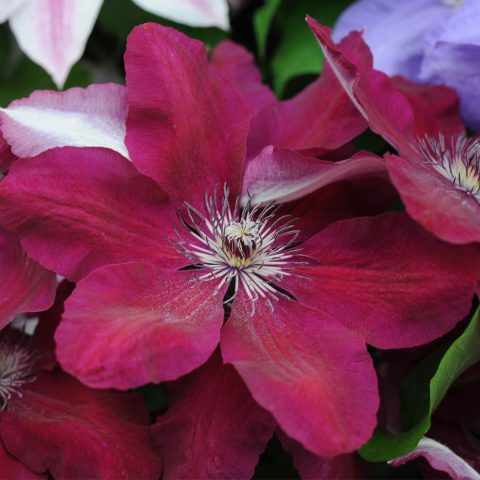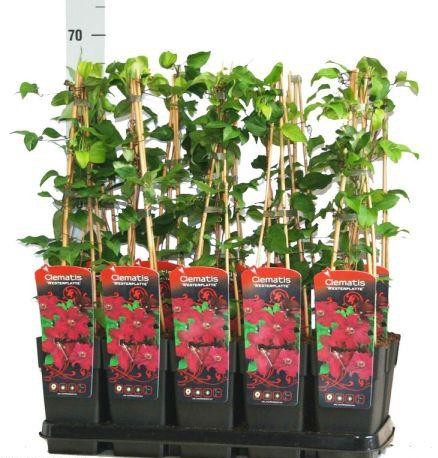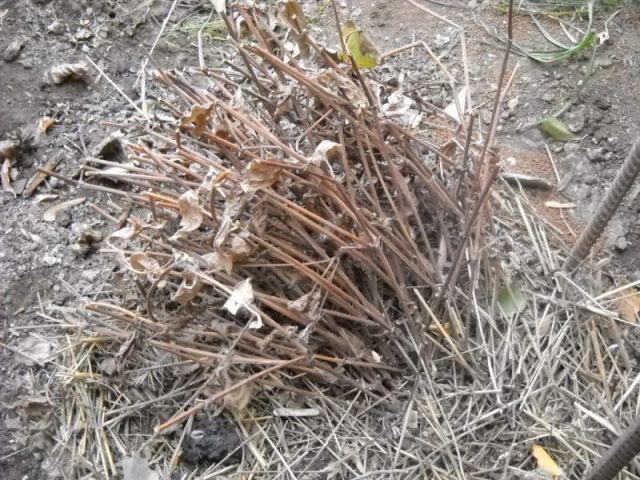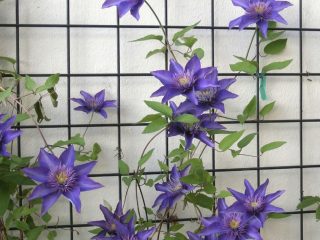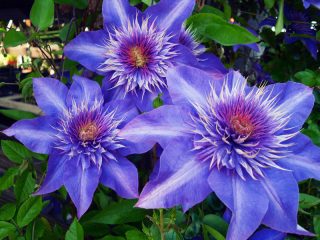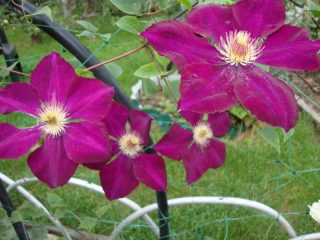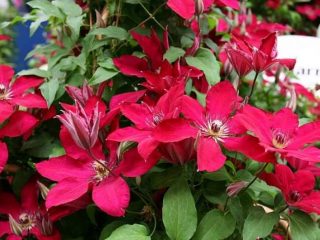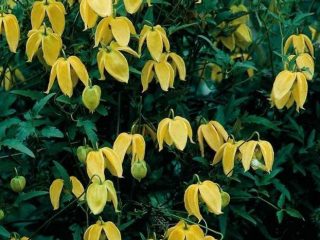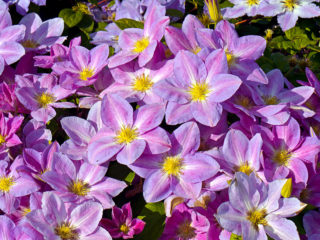Content
Clematis Westerplatte is a variety of Polish selection. Bred by Stefan Franczak in 1994. The variety has a gold medal received in 1998 at an international exhibition. Climbing large-flowered vines are used for vertical gardening of gardens and balconies. To grow clematis Westerplatte, supports are needed, so high walls, fences or gazebos are most often decorated with vines.
Description of clematis Westerplatte
Clematis Westerplatte is a perennial deciduous plant. The growth force of the stems is average. Lianas are highly decorative and for several years create a dense carpet of leaves and flowers.
Under favorable growing conditions, the stems reach 3 m in height. Lianas are flexible and can be given the desired direction when growing.
The plant produces large, velvety flowers, 10-16 cm in diameter. The color of the flowers is rich, garnet. Bright flowers do not fade in the sun. The sepals are large and slightly ruffled at the edges.There are several grooves running down the middle. The stamens are light: from white to cream color. The leaves are green, obovate, smooth, arranged oppositely.
The description of the clematis variety Westerplatte states that with proper formation, the plant shows abundant flowering from July to August. During this time, two waves of flowering take place: on the shoots of the previous and current year. In the second period, flowers are located along the entire length of the vine.
The frost resistance of the variety belongs to zone 4, which means the plant can withstand temperatures of -30... -35°C without shelter.
Clematis Westerplatte pruning group
Clematis (Westerplatte) Westerplatte belongs to the 2nd pruning group. The main flowering occurs on last year's shoots, so they are preserved. Clematis Westerplatte is trimmed 2 times.
Trimming plan:
- The first pruning is carried out in mid-summer after last year's shoots have faded. At this time, the stems are cut off along with the fruit.
- The second time the shoots of the current year are pruned at the time of winter shelter. The shoots are cut off, leaving a length of 50-100 cm from the ground.
Light pruning allows the vines to bloom luxuriantly all summer. With radical pruning of all vines, clematis Westerplatte will bloom only from mid-summer on shoots that have grown this year. According to the photo, description and reviews, clematis Westerplatte produces fewer flowers when completely pruned.
Optimal growing conditions
Clematis Westerplatte is grown in lighted areas. But the peculiarity of the culture is that only vines should be in the sun, and the root part is shaded. To do this, annual flowers are planted at the base of the plant.For shading, perennial plants with a shallow root system are also planted at a short distance.
The plant forms very delicate stems with thin clinging tendrils. Therefore, the growing area should not be heavily blown, and the trellis should have a small cell.
Planting and caring for clematis Westerplatte
To plant clematis Westerplatte in a garden plot, seedlings with a closed root system, usually growing in containers, are purchased. It is best to plant plants older than 2 years. Such seedlings of the Westerplatte variety should have a well-developed root system, and the shoots at the base should be lignified. Transplantation can be carried out throughout the warm season.
Selection and preparation of a landing site
The site for growing clematis in Westerplatte is chosen taking into account the fact that the crop will grow in a permanent place for a long time, because adult clematis does not tolerate transplantation well.
The growing site is chosen on a hill; the roots of the plant do not tolerate stagnant moisture. The soil is cleared of weedso as not to provoke the occurrence of fungal diseases. The culture is suitable for growing in large containers.
Seedling preparation
Before planting, the seedling can be stored in a container in a bright place. Before planting, the plant and container are left for 10 minutes. into water to saturate the roots with moisture.
The earthen ball is not broken when planting. To disinfect the roots, they are sprayed with a fungicide. For better rooting and stress relief during transplantation, the seedling is sprayed with Epin solution.
Landing rules
To plant clematis Westerplatte, prepare a large planting hole measuring 60 cm on all sides and in depth.
Planting plan:
- A drainage layer of gravel or small stone is poured onto the bottom of the planting hole. On light, permeable soils, this step can be skipped.
- A bucket of mature compost or manure is poured onto the drainage.
- Then pour a small amount of garden soil mixed with peat.
- The seedling must be placed in the substrate 5-10 cm below the general ground level. During the season, fertile soil is gradually replenished, completely filling the remaining space. This is an important rule when planting large-flowered clematis. With this placement, the plant will form additional roots and shoots to form a lush crown.
- The seedling is covered with a mixture of garden soil, peat, 1 tbsp. ash and handfuls of complex mineral fertilizer.
- The soil at the planting site is pressed and watered abundantly.
Clematis Westerplatte is planted together with other varieties and plants. To do this, a distance of about 1 m is maintained between crops. The variety is often used in joint planting with roses. To prevent the rhizomes of different crops from touching, they are separated with roofing felt when planting.
Watering and fertilizing
When growing clematis Westerplatte, it is important not to let the soil dry out. A large volume of water is used per watering: 20 liters for young plants and 40 liters for adults. Water clematis not at the root, but in a circle, retreating 30-40 cm from the center of the plant. When watering, they also try not to touch the stems and leaves of the vine to avoid the spread of fungal diseases.
Liquid fertilizers for flowering plants, for example, Agricola 7, are used as fertilizers. The number of applications depends on the initial soil fertility and the condition of the plant. Lianas are not fertilized with fresh manure.
Mulching and loosening
Surface loosening is carried out at the beginning of the season together with the removal of weeds and old mulch. In the future, loosening with tools is not recommended due to the danger of damaging the roots and delicate stems; it is replaced by mulching.
Mulching for Westerplatte clematis is an important agricultural technique. To protect the roots, coconut tree trunk circles, wood chips or sawdust are laid out on the soil around the bushes. The material allows you to keep the soil moist and breathable and prevents weeds from germinating.
Trimming
During the season, weak and dry vines are cut out from Westerplatte clematis. After flowering, last year's shoots are cut off completely. For shelter for the winter, leave 5-8 shoots with buds.
Preparing for winter
Clematis Westerplatte is a frost-resistant plant. But the shoots and roots are covered for the winter to avoid damage to the plant during thaws and frosts. Cover the plants in late autumn on slightly frozen soil. Before this, remove all plant debris, fallen and dried leaves, including from the stems.
The roots are covered with a dry substrate: peat or mature manure, filling the voids between the stems. The remaining long shoots are rolled into a ring and pressed to the soil with material that is not subject to rotting. Spruce branches are placed on top, then a covering waterproof material.
In the spring, the covering layers are removed gradually, focusing on weather conditions, so that the plant is not damaged by return frosts, but also does not become locked in the shelter. The growing season begins at temperatures above +5°C, so overwintered shoots need to be tied up in time.
Reproduction
Clematis Westerplatte is propagated vegetatively: by cuttings, layering and dividing the bush. Propagation by seeds is less popular.
Cuttings are taken from an adult plant over 5 years old before it blooms. Propagation material is cut from the middle part of the vine. Root the cuttings in planting containers with a peat-sand mixture.
Clematis reproduces well by layering. To do this, the outermost shoot of an adult plant is placed in a groove, in the soil and sprinkled. Once roots have formed, the new shoot can be transplanted into a pot without being separated from the vine, and grown throughout the summer season.
In order to propagate clematis by dividing the bush, you need to dig up the bush completely. This method is used only for plants under 7 years of age. Older specimens have a very overgrown root system and do not take root well if it is damaged.
Diseases and pests
With proper care, Clematis Westerplatte is resistant to diseases and pest damage. But when grown in a shaded, unventilated or damp area, it is susceptible to powdery mildew and other fungal diseases. To protect the plants, they are transplanted to a more suitable location. For prevention, at the beginning of the season, spray with solutions of copper or iron sulfate.
Serious diseases of clematis are various wilts:
- Fusarium wilt caused by a fungus, occurs at high air temperatures.Weakened shoots become infected first, so they must be removed in time.
- Verticillium wilt or wilt - a common disease of clematis. Occurs when grown in acidic soils. For prevention, the soil must be limed. To do this, at the beginning of the season, the soil is watered with lime milk, which is prepared from 1 tbsp. lime or dolomite flour and 10 liters of water.
- Mechanical withering provokes swaying of vines in strong winds and their damage. Plants must be protected from drafts and attached to a reliable support.
Prevention of wilting is the acquisition of healthy seedlings, their correct, deep planting and care.
Clematis hybrid Westerplat does not have specific pests, but can be damaged by common garden parasites: aphids, spider mites. Roots are damaged by mice and mole crickets. You can partially protect plants from rodents by installing a fine-mesh mesh around the root system.
Conclusion
Clematis Westerplatte is a perennial plant for vertical gardening. It grows in a suitable place for several decades. Large burgundy flowers against a background of dense greenery will decorate the southern walls of buildings and fences, as well as individual columns and cones. Suitable for growing in different climatic zones and is an unpretentious variety.
